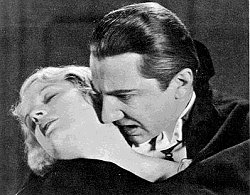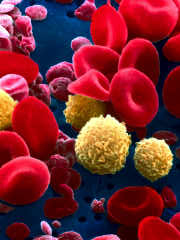| Would you believe that blood is
considered a connective tissue?
 Blood
is a tissue in which highly specialized cells are suspended in a
fluid matrix called plasma. Blood serves to transport many diverse
substances, from gases, nutrients, and wastes to information bearing
molecules such as hormones and antibodies. Histologically, blood is
sometimes classified as a specialized form of connective tissue. In
stained blood smears, one can quickly distinguish between the oxygen
bearing erythrocytes without nuclei and the basophilic, nucleated
leukocytes which perform diverse roles in bodily defense.
Recognition of the cell types, particularly leukocytes, and the
significance of their relative numbers are frequently important in
medical diagnoses. Blood in adults is produced in bone marrow and an
examination of marrow reveals immature forms of the various blood
cells and platelet-producing cells. Blood
is a tissue in which highly specialized cells are suspended in a
fluid matrix called plasma. Blood serves to transport many diverse
substances, from gases, nutrients, and wastes to information bearing
molecules such as hormones and antibodies. Histologically, blood is
sometimes classified as a specialized form of connective tissue. In
stained blood smears, one can quickly distinguish between the oxygen
bearing erythrocytes without nuclei and the basophilic, nucleated
leukocytes which perform diverse roles in bodily defense.
Recognition of the cell types, particularly leukocytes, and the
significance of their relative numbers are frequently important in
medical diagnoses. Blood in adults is produced in bone marrow and an
examination of marrow reveals immature forms of the various blood
cells and platelet-producing cells.
 The
learning objectives for this module are: The
learning objectives for this module are:
- Distinguish the histological
organization of a red bone marrow core biopsy, bone marrow
smear, and peripheral blood smear.
- Describe and identify
erythrocytes, megakaryocytes, and platelets in light and
electron micrographs.
- Recognize and describe the
structure of neutrophils, eosinophils, basophils, and monocytes
in light and electron micrographs.
- Describe and identify the
structure of lymphocytes in light and electron micrographs.
Consult this diagram of the
developmental
sequence to help understand and recognize the intermediate cells in the formation
of red blood cells and the three types of granulocytes.
Let's go straight to
a blood smear. |